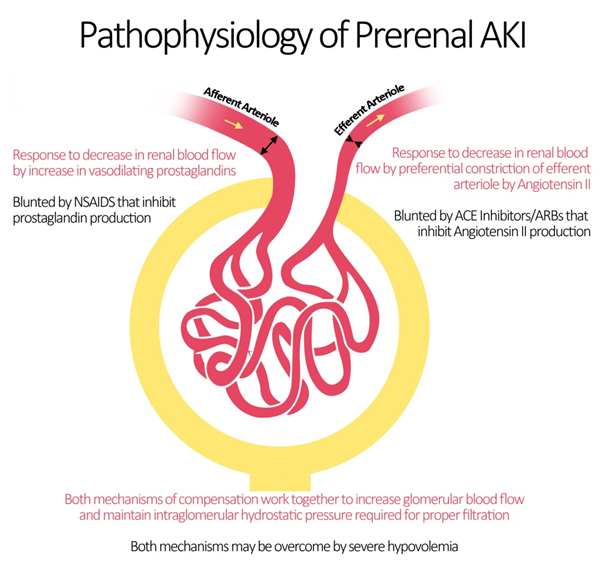WBR0404
| Author | [[PageAuthor::Yazan Daaboul, M.D. (Reviewed by Yazan Daaboul, M.D. and Alison Leibowitz [1])]] |
|---|---|
| Exam Type | ExamType::USMLE Step 1 |
| Main Category | MainCategory::Pathophysiology |
| Sub Category | SubCategory::Renal |
| Prompt | [[Prompt::A 72-year-old man is brought to the emergency department (ED) with high-grade fever and confusion. The patient is admitted to the hospital for appropriate management. The next day, the patient's Foley catheter yields less than 100 mL of dark yellow urine over 24 hours. Further work-up demonstrates the values illustrated in the table shown below. What is the most likely cause of this patient’s oliguria? |
| Answer A | AnswerA::Acute interstitial nephritis |
| Answer A Explanation | [[AnswerAExp::Acute interstitial nephritis is a type of renal injury that would not typically manifest with high BUN/Creatinine ratio. In contrast, intrinsic renal causes of acute kidney injury typically manifest with a BUN/Creatinine ratio < 15 and urine osmolarity commonly < 350 mOsm/kg.]] |
| Answer B | AnswerB::Bilateral renal cortical necrosis |
| Answer B Explanation | [[AnswerBExp::Diffuse bilateral renal cortical necrosis is also a type of intrinsic renal injury that would not typically manifest with the lab values shown in the table. Diffuse bilateral renal cortical necrosis is usually an obstetric complication, but it may also occur following trauma or sepsis.]] |
| Answer C | AnswerC::Renal stone complicated with hydronephrosis |
| Answer C Explanation | [[AnswerCExp::Renal stone with hydronephrosis is a type of post-renal acute kidney injury that would typically manifest with elevated urinary sodium > 40 mEq/L.]] |
| Answer D | AnswerD::Urinary tract infection complicated by acute pyelonephritis |
| Answer D Explanation | [[AnswerDExp::The hallmark of pyelonephritis is WBC casts, which are absent in this patient. Accordingly, the diagnosis of acute pyelonephritis in this patient is less likely. In addition, acute pyelonephritis does not typically manifest with an elevated BUN/Creatinine ratio.]] |
| Answer E | AnswerE::Severe hypotension |
| Answer E Explanation | [[AnswerEExp::Hypotension may result from septic shock and may lead to pre-renal acute kidney injury. Pre-renal azotemia is characterized by a BUN/Creatinine ratio > 20, urinary osmolarity > 500 mOsm/kg, and urinary sodium < 20 mEq/L.]] |
| Right Answer | RightAnswer::E |
| Explanation | [[Explanation:: Acute kidney injury (AKI), formerly known as acute renal failure, is characterized by an abrupt loss of kidney function resulting in a failure to excrete nitrogenous waste products (among others), and a disruption of fluid and electrolyte homeostasis. AKI defines a spectrum of disease with common clinical features including an increase in the serum creatinine and BUN levels, often associated with a reduction in urine volume. AKI can be caused by a multitude of factors broadly categorized into pre-renal (usually ischemic), intrinsic renal (usually toxic), and post-renal (usually obstructive) injuries. The patient’s presentation and lab values are characteristic of pre-renal acute kidney injury. Septic shock predisposes to acute kidney injury via ischemic, reperfusion, and direct inflammatory damage and is a common cause of pre-renal acute kidney injury. To differentiate different types of acute kidney injury, calculation of BUN/Creatinine ratio is helpful. BUN/Creatinine = 80 / 2.5 = 32. Since the ratio is greater than 20, accompanied by elevated urine osmolarity > 500 mOsm/kg and urinary sodium < 20 mEq/L, the diagnosis of pre-renal azotemia is more likely than other renal or post-renal etiologies. |
| Approved | Approved::Yes |
| Keyword | WBRKeyword::Pre-renal azotemia, WBRKeyword::Urinary sodium, WBRKeyword::Renal injury, WBRKeyword::Hypotension, WBRKeyword::BUN/creatinine, WBRKeyword::Prerenal acute kidney injury, WBRKeyword::Acute kidney injury, WBRKeyword::Acute tubular necrosis, WBRKeyword::Interstitial nephritis |
| Linked Question | Linked:: |
| Order in Linked Questions | LinkedOrder:: |


